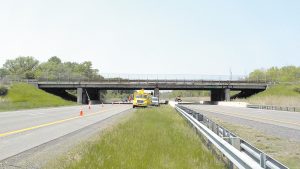SYRACUSE — The Connective Corridor project has punched its ticket for downtown Syracuse. Syracuse University (SU) and the city of Syracuse provided an update on their joint project in a public information session Jan. 23 at SU’s Warehouse at 350 W. Fayette St. That building is the endpoint of planned Connective Corridor infrastructure work —streetscape […]
Get Instant Access to This Article
Become a Central New York Business Journal subscriber and get immediate access to all of our subscriber-only content and much more.
- Critical Central New York business news and analysis updated daily.
- Immediate access to all subscriber-only content on our website.
- Get a year's worth of the Print Edition of The Central New York Business Journal.
- Special Feature Publications such as the Book of Lists and Revitalize Greater Binghamton, Mohawk Valley, and Syracuse Magazines
[bypass-paywall-buynow-link link_text="Click here to purchase a paywall bypass link for this article"].
SYRACUSE — The Connective Corridor project has punched its ticket for downtown Syracuse.
Syracuse University (SU) and the city of Syracuse provided an update on their joint project in a public information session Jan. 23 at SU’s Warehouse at 350 W. Fayette St. That building is the endpoint of planned Connective Corridor infrastructure work —streetscape and public-transportation improvements designed to connect Syracuse University with the city’s downtown.
Economic development is a major goal of the work, according to Owen Kerney, deputy director of planning and sustainability for the city of Syracuse.
“By doing this we’re also bringing more people down to this corridor, using this corridor, and I would hope that they’re utilizing the businesses along the corridor,” he says. “I hope they’re using the services, the restaurants, the institutions, and other things that you find along the corridor.”
The Jan. 23 information session laid out a timeline for the corridor’s second and third phases. Work on its first phase, which included streetscape development stretching from University Avenue in front of SU’s Hall of Languages to Forman Park on East Genesee Street, started in 2011 and wrapped up in the fall of 2012. It cost $10 million and was funded by federal grants, the city of Syracuse, Onondaga County, and SU, according to Kerney.
Now the city and university are finalizing second- and third-phase plans to extend the streetscape work west on East Genesee Street. It will then jump to Fayette Street at Firefighter’s Memorial Park before continuing to SU’s Warehouse.
Designs are in the process of being finalized. The project’s second and third phases are scheduled to be ready for bids by June, and work is slated to begin later in the summer. Construction will continue through October before stopping for the winter and resuming in March or April 2014. It will again shut down for winter in October 2014 before resuming the next spring for a final estimated completion date of summer 2015.
Total project cost for the second and third phases is $14.8 million. A U.S. Department of Transportation TIGER grant makes up $10 million, with another $1 million coming from Onondaga County and $3.8 million from SU.
Salina–based Barton & Loguidice is the project’s engineering firm. No construction contractors are in place for its second and third phases, but Barrett Industries, which has a regional office in Clay, and Ballard Construction, Inc. of Solvay worked on its first phase, according to Kerney.
Planned corridor improvements include new sidewalks, snow storage areas, bicycle lanes, and vehicle travel lanes. And they include signage, landscaping, lighting, and bus pull-ups.
Linda Dickerson Hartsock, director of community engagement and economic development at SU, also spoke about planned improvements on what she called Syracuse’s “Civic Strip.” That strip is bordered by Water Street, State Street, Montgomery Street, and Adams Street. It includes Jefferson Street, a street that “UPSTATE: A Center for Design, Research, and Real Estate,” part of SU’s School of Architecture, wants to light.
“Jefferson Street is dark at night,” Hartsock said during the informational meeting. “So UPSTATE: is working with lighting designers and lighting technologists and National Grid and the city to look at a relatively unique and innovative overhead lighting treatment that would help draw people down Jefferson Street.”
A new round of façade-improvement grants will soon be available for buildings along the Connective Corridor, according to Hartsock. Empire State Development awarded $250,000 for façade improvements on the corridor as part of the state’s recent Regional Economic Development Council awards. Building owners will be able to start applying for chunks of that funding in February.
The façade improvements come after $625,000 in grants funded work at 40 buildings during the Connective Corridor’s first phase, Hartsock added.
Contact Seltzer at rseltzer@cnybj.com



